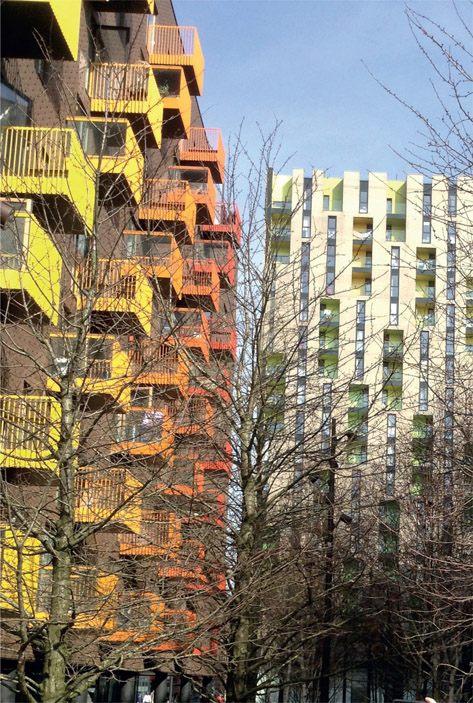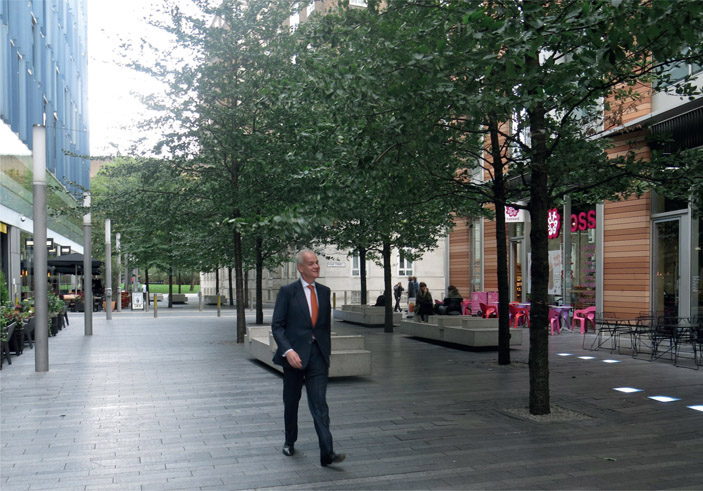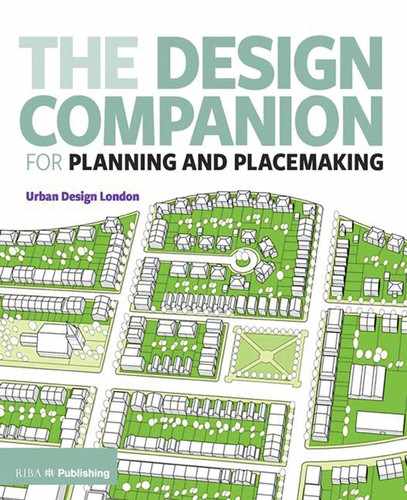1
What is design and how does it relate to planning?
In the context of planning, design is the process of devising the physical form of development.
The planning system in the UK is concerned with land use – deciding which uses should go in which location, and the relationships between these uses. Government attitudes to how planning should control or influence land use have varied over the years. Planning is also concerned with the physical form of development, which plays an important part in determining if a place is successful, and whether national priorities are achieved. It is this physical side of planning that forms the subject for this book.
The planning system seeks to influence a development’s layout, height, massing and appearance, among other things. It seeks not just to manage land use, but to support the creation – in other words the design – of successful places. High standards of design are a core planning principle of the NPPF, further explained in the online PPG. The NPPF should be taken into account in policymaking and decision-making.
The NPPF and Planning Practice Guidance (PPG) can be found side by side on the government’s website: www.gov.uk
What are the NPPF and PPG?
Together they set out what the planning system should do. The NPPF is the highest-level planning policy, to which all other policies should generally conform. The PPG explains how to apply the NPPF. This book refers to NPPF wording, explaining what it requires in terms of design. It complements ideas and information in the PPG, but does not refer to this sister text explicitly.
The design of places is an important part of planning at every scale. The design of individual buildings (including their disposition and detailed treatment) determines how well they work, how they fit into their surroundings and how attractive they are. This is managed through planning applications and the application of planning policies.
Context is the key. Successful development is planned and designed through processes that involve a deep understanding of a place and what makes it unique.
Planning and Design: Three Factors
Development planning and design involves:
- Public policy objectives
- Place characteristics that help to meet these objectives
- Development forms that help to create these characteristics
Political objectives vary with changes in government, public opinion and circumstances. In the work of regional, city or local government administrations, they can include the following: Figure 1.1 Planning contributes to the design of places at every scale. Here much thought and care has gone into creating a new high-density quarter within a town centre.
Achieving these objectives requires many types of political action. Planning, including its impact on the design of buildings and places, can contribute to all of them. That is why it is appropriate that planning operates through the political system – with elected politicians, from the secretary of state down to ward and parish councillors, directly involved in planning decisions. Since the age of Vitruvius (first century BC), the three most important characteristics of sucsessful development have been identified as durability, fitness for purpose and beauty. The NPPF states: ‘Planning policies and decisions should aim to ensure that developments: will function well and add to the overall quality of the area, not just for the short term but over the lifetime of the development … are visually attractive as a result of good architecture and appropriate landscaping’.1 Achieving that aim (and the political objectives described above) will depend on eight characteristics of successful places (discussed in more detail within Chapter 2):
The rest of Paragraph 58 of the NPPF, after referring to Vitruvius’s three qualities, sets out these characteristics. Development, it states, should ‘establish a strong sense of place, using streetscapes and buildings to create attractive and comfortable places to live, work and visit; optimise the potential of the site to accommodate development, create and sustain an appropriate mix of uses (including incorporation of green and other public space as part of developments) and support local facilities and transport networks; respond to local identity and history, and reflect the identity of local surroundings and materials, while not preventing or discouraging appropriate innovation; create safe and accessible environments where crime and disorder, and the fear of crime, do not undermine quality of life or community cohesion; and be visually attractive as a result of good architecture and appropriate landscaping.’ The wording used in the NPPF combines political objectives (such as crime prevention) and place characteristics which can help to deliver the objectives (such as high-quality public space). This can be a little confusing, but the policy provides a clear requirement for good design and supports planners’ efforts to create successful places. Planning applications specify the form of the proposed development; local planning policies seek to influence it; and the viability, deliverability and acceptability of schemes depend on it. Chapter 3 will look at the following aspects of development form in more detail:
At what stage in the process these matters should be decided is a difficult question. Developers might want to leave them open until they know that their scheme is acceptable in principle. Communities, planners and politicians might struggle to consider the principles if they do not know what the scheme will look and feel like. Clear planning policies and design guidance can set out the parameters of what will be acceptable, while conditions accompanying any permission can seek to ensure that details drawn up in the future will be appropriate. Working through the different processes involved, and understanding the motivations behind the actions of different players, will help to achieve better outcomes. We look at how the design and planning processes dovetail, and who gets involved when, in Chapter 6.
Public policy objectives

Place characteristics
Development form
Planning and Design at Various Scales
Political objectives, place characteristics and development form relate to one another at a variety of scales. At the large scale, such as planning and designing a whole settlement or significant neighbourhood, the focus will be on creating a new place that will work well and mature successfully. This is likely to entail looking at the distribution and intensity of uses, the shape and richness of the movement network, the three-dimensional structure of neighbourhoods, and the attributes (both positive and negative) of the site and surrounding area. Matters at this scale are managed through statutory plans, masterplans and infrastructure strategies.
When working at a relatively large scale, we need to consider what the broad patterns of use should be, what the essentials of the movement pattern are, what principles for providing public and private space are appropriate, how change will be accommodated (respecting factors such as local distinctiveness), and how resources can be used most efficiently.
Successful design at this larger scale should ensure that development supports political objectives such as creating a buoyant local economy and a place that flourishes socially; meeting environmental goals; and integrating new development into the natural, built and historic environment.

Figure 1.2
Development can provide new high-quality public space.
At the medium scale, schemes might include one or two new urban blocks, with perhaps a new street and other public space, as shown in Figure 1.2. Such schemes often focus on one land use, such as housing, but where appropriate they should include ancillary uses to serve the new residents, such as a local shop, community centre or school. The focus at this scale is on creating a place that works as an entity, with the particular challenge of fitting well into an existing area.
Success at this scale will rely on an understanding of the surrounding area, its identity, land use and movement patterns, so that the scheme can complement and improve them. The edges of such schemes are particularly important. One common approach that can work well is to put the back of new buildings facing the back of existing ones. Another is to leave an open space as a buffer area between the old and new developments, if this will not have an isolating effect.
At the smallest scale, planning and design focuses on the impact of change on the immediate neighbours and the wider street scene. Issues such as loss of outlook, light and noise nuisance become important.
Emotions Matter
Success in creating places is measured in part by users’ emotional reactions. Places can provoke anxiety, boredom, disgust, fear or frustration, and sometimes even anger, hatred, outrage, panic or shock. Successful places, on the other hand, provoke feelings of contentment, curiosity, delight, happiness, pleasure or pride, and sometimes even excitement, surprise or wonder. Such emotions can have a profound effect. They are often directly related to characteristics of the physical environment or to past events that make it distinctive.
For example, poorly lit routes and spaces might frighten some people into taking a circuitous route to avoid them, or even staying indoors at night. Well-connected spaces might attract people, who will in turn attract others by the interest and liveliness they bring. Buildings themselves can be full of interest through their activities, and can also contribute positively to places and spaces nearby. Some buildings and places display evidence that they were designed and made by people with flair and delight in their job. Others convey the depressing message that no one cared, or cares.
Issues such as the emotional response to place are at the heart of having a planning system to manage change in our environments in the public interest. How people feel about places, and the feelings of pride, fear or depression those places can imbue us with, have a significant impact on civic society, public health and economic vitality.
Emotional response is not the same as individual taste or preference, nor is it shaped solely by cultural affiliation. It relates more fundamentally to how we use and share buildings and spaces.
